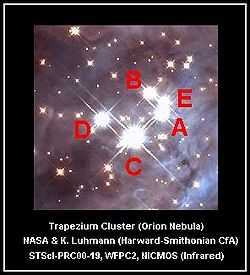Theta1 Orionis C
 Theta1 Orionis C and companions. | |
| Observation data Epoch J2000 Equinox J2000 | |
|---|---|
| Constellation | Orion |
| Right ascension | 05h 35m 16.5s |
| Declination | −05° 23′ 24″ |
| Apparent magnitude (V) | 5.13 |
| Characteristics | |
| Spectral type | O6pe V |
| U−B color index | −0.88 |
| B−V color index | +0.02 |
| Variable type | ? |
| Astrometry | |
| Radial velocity (Rv) | +28 km/s |
| Proper motion (μ) | RA: −0.92 mas/yr Dec.: 0.13 mas/yr |
| Parallax (π) | 2.11 ± 0.41 mas |
| Distance | approx. 1,500 ly (approx. 470 pc) |
| Absolute magnitude (MV) | −3.2 |
| Details | |
| Mass | 40 M☉ |
| Radius | 8 R☉ |
| Luminosity | 251,000 L☉ |
| Temperature | 45,500 K |
| Metallicity | ? |
| Rotation | ~112 km/s |
| Age | 1.2 × 106 years |
| Other designations | |
41 Ori C, HR 1895, HD 37022, SAO 132314, V1016 Ori. | |
| Database references | |
| SIMBAD | data |
Theta1 Orionis C is a member of the Trapezium open cluster that lies within the Orion Nebula. The star C is the most massive of the four bright stars at the heart of the cluster. It is an O class blue main sequence star and has the highest surface temperature of any star visible to the naked eye; it is one of the most luminous stars known, with an estimated absolute magnitude in visible wavelengths of about −3.2. Its high luminosity and large distance (about 1,500 light years) give it an apparent visible magnitude of 5.1.
This star is responsible for generating most of the ultraviolet light that is slowly ionizing (and perhaps photoevaporating) the Orion Nebula. This UV light is also the primary cause of the glow that illuminates the Orion Nebula. The star emits a powerful stellar wind that is a hundred thousand times stronger than the Sun's, and the outpouring gas moves at 1,000 km/s.
Infrared observations of Theta1 Orionis C have shown that it is actually a close binary system. It also displays optical variability and is a variable X-ray source. Separate components of the system were resolved in visible light in August of 2013 with adaptive optics system installed to Magellan telescope. [1]
It is expected that this star will expand into a red supergiant and end its life as a supernova within a few million years from now.
References
- ↑ New Telescope Tech Takes Sharpest Night Sky Photos Ever, Mike Wall, 2013.
- Gagne, Marc; et al. (1997). "Periodic X-Ray Emission from the O7 V Star θ1 Orionis C". Astrophysical Journal Letters 478 (2): L87–L90. arXiv:astro-ph/9701145. Bibcode:1997ApJ...478L..87G. doi:10.1086/310558.
- Walborn, N. R. (1981). "Systematic variations in the spectrum of Theta-1 Orionis C". Astrophysical Journal 243 (1): L37–L39. Bibcode:1981ApJ...243L..37W. doi:10.1086/183438.
External links
| ||||||||||||||||||||||||||